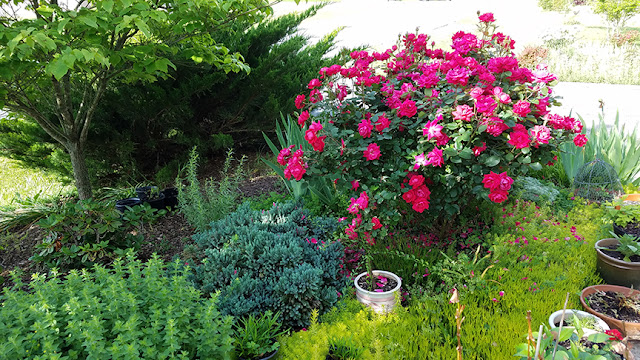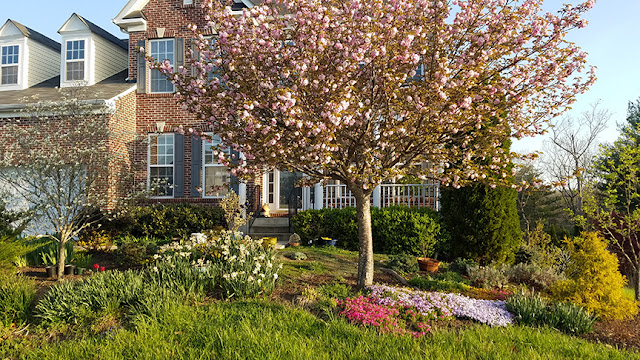 |
| Itoh Peony 'Bartzella' |
 |
| Bartzella |
Late May is such a wonderful time of the year for flowers! Peonies, roses, clematis, azaleas, wildflowers, just about everything seems to bloom at this time of the year. After the recent rainy spell, my garden looks fabulous! That is, as long as you don't look too closely at the weedy lawn.
My peonies put on a gorgeous show this spring: the yellow Itoh 'Bartzella' produced seven huge, dinner-plate size blossoms. 'Duchesse de Nemours' is so heavy with blooms that even with grow-through wire supports, the recent rains broke off a few stems. The perfect excuse to cut and bring them into my house to fill a vase for sketching.
 |
| Peony 'Duchesse de Nemours' |
 | |
| 'Duchesse de Nemours' |
The pink peony in the front bed by the driveway was the first peony I planted in my garden, and it has been putting on a show since then. Peonies are long-lived plants, and usually bloom in greater profusion every year if they're happy in their location.
 | |
| Pink peony in front bed. |
 |
| Pink peony, alliums and shrub roses in bed by driveway. |
 |
| Shrub rose 'Petal Pusher' with blue Fescue and yellow alliums. |
The sunny bed by the driveway with the pink peony is fuller this year with yellow alliums, and the roses are now starting to bloom. I don't recall the tufts of blue fescue grass blooming so profusely before, they are stunning this year!
 |
| Red 'Double Knockout' rose by the front walk. |
 |
| Ground covers by the front walk. |
The red 'Double Knockout' rose by the front walk is lovely with its first flush of bloom, and will keep on blooming until the first frost, if not as profusely--I only wish it had some perfume! The rest of the ground covers and shrubs along the walk are lush too; the Persian carpet effect I wanted here is coming together nicely. The blue-green foliage of woolly thyme and Juniper contrasts nicely with the yellow-greens of the sedum 'Angelina' and a miniature golden Hinoki false cypress, and the fresh green of Greek oregano, accented with the clump of magenta pink dianthus flowers.
 |
| Clematis 'Etoile Violette' |
My clematis 'Etoile Violette' took a beating last year when the climbing rose 'New Dawn' was blown down off the porch pillar during a storm. The rose had to be pruned back severely, which I don't think hurt it any. This year it looks as if 'New Dawn' will bloom a bit later, so the two will not coincide. I like the color combination of these three plants: the deep purple clematis with a golden Hinoki cypress and a dwarf Colorado blue spruce.
 |
| East garden in the evening. |
Moving along the east of the house, three Japanese maples provide shelter for shade-loving plants like the Rhododendron and two azaleas. The photo above was taken last week, the one below a few days later. The Japanese maples are a red-leaved 'Bloodgood', a full-moon maple 'Shirasawanum', and between these two, a small-leaved one I grew from a seedling found in the grounds of the office building next to the one I used to work in.
 |
| Same bed in morning light, pagoda dogwood on the left, fringe tree on the right. |
 |
| 'Blue Barlow' columbines with Fringe tree and Japanese maples. |
The Virginia Fringe tree (Chionanthus virginianus) and Pagoda dogwood (Cornus alternifolia) blooming at the same time with the columbines really made this area of the garden sing this year. The great blue Lobelias are spreading all over this bed, competing with the 'Blue Barlow' columbines. Later in the year the Lobelias will cover the bed with their blue spikes of flowers.
 |
| Dutch iris, 'Major Wheeler' honeysuckle and double flowering Quince |
In the back yard, the deep blue Dutch iris sets off the honeysuckle 'Major Wheeler' while the double flowering quince continues to bloom in the long island bed. In the same bed, the elderberry 'Black Lace' and other plants bloom, waiting for the Asian lilies to make their entrance.
 |
| Clematis 'John Warren' |
 |
| Elderberry (Sambucus 'Black Lace') |
 |
| Pentstemon 'Electric Blue' |
 |
| Foxglove Pentstemon |
Last fall I transplanted one of the foxglove Pentstemons to the Herb bed and another to the back bed, where they are flourishing. Meanwhile, the Badlands shine with the same foxglove Pentstemons and the blooms of 'Coppertina,' a ninebark tree (Physocarpus opulifolium 'Coppertina). The deer eat this shrub back every year so it doesn't seem to get any bigger, but they seem to have stopped devouring my other ninebark tree, 'Amber Jubilee' in another bed, allowing it to produce its first blooms this year.
 |
| Ninebark tree 'Coppertina' |
 |
| Ninebark tree 'Amber Jubilee' |
I'd forgotten to show you my 'Kousa' dogwood, which has more blooms this year, despite the ravages of the 17-year locusts last year.
 |
| 'Kousa' dogwood in back bed. |
I can't wait to see what marvelous new blooms the season will bring forth soon!












































